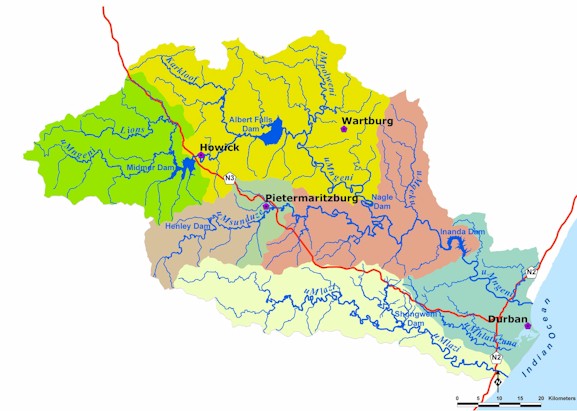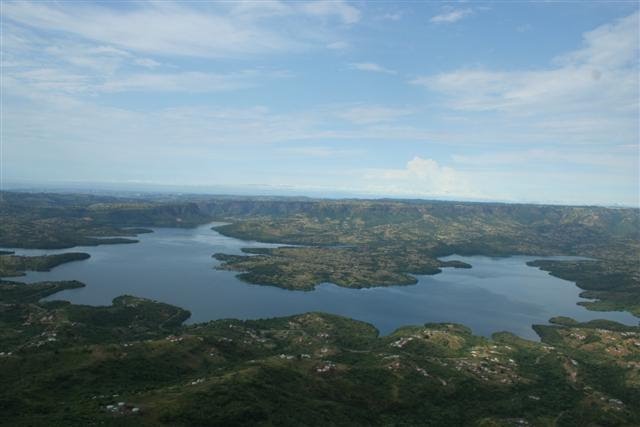Patrick Martel is a University of the West of England (UWE) / Institute of Natural Resources NPC (INR) intern. Based in Durban, South Africa, his work is funded by the International Water Security Network and is under the supervision of Professor Chad Staddon (University of the West of England) and Duncan Hay (INR). Patrick is in the process of registering for a PhD in Development Studies at the University of KwaZulu-Natal.

The focus of my internship is to examine urban water security within the eThekwini Municipality (the local government for Durban), by applying the urban hydrosocial transition model to this study area. Durban is an interesting case study, which has significant transformation and development challenges within a water-scarce context. South Africa is one of the 30 driest countries in the world; however, Durban is located within KwaZulu-Natal, which is the province which receives the most rainfall. This city is the second most populated urban centre within the country, and falls within the jurisdiction of the eThekwini Municipality, which is approximately 2,297km2 in size, and home to approximately 3.5 million people. Durban is one of two large cities that fall within the uMngeni catchment, and is heavily reliant on surface water for its water supply.
In order to understand Durban’s water security, I will be applying the urban hydrosocial transition (UHT) model to this study area. With this historical geographic framework, cities can be conceptualised as manifestations of successive hydrosocial contracts between agents of economic, political, cultural and technological change (Staddon and Langberg, 2014). Analysing the historical and geographic processes involved in the making and remaking of water and society provides analytical insights into the social construction and production of water in a given time and space, as well as the ways that this becomes evident to society and the power relations which instigate hydrosocial change (Linton and Budds, 2014). This model is characterised by three distinct phases, namely hydro-precarity (pre-1914); hydro-modernism (1914-1992); and hydro-security (post-1992). When applying this model, the researcher identifies case studies for each phase; as well as unique factors and the underlying drivers of change which have influenced water security over time.
Hydro-precarity refers to the phase where water services were characterised as being piecemeal and chaotic local arrangements (Staddon and Langberg, 2014). During the hydro-precarity phase in Durban, my research examines water security from the creation of the Borough of Durban in 1854, where water supply was reliant on private wells and rainwater. After the laying of the first water pipe network and the supply of water through public wells, the local government began to provide water for the general public. This was achieved by plumbing into the Umbilo, Umhlatuzana and Umlaas Rivers, under the guidance of long-standing, powerful engineers. From this point onwards, Durban was reliant on surface water. It is imperative to note that natural disasters, particularly flooding and drought, threatened Durban’s water security, and resulted in the incremental development of water services over time.

At the turn of the twentieth century, the population of Durban increased and the Borough expanded spatially. As a result, more water was required from further away and this signalled the beginning of the hydro-modernism phase in Durban. Hydro-modernism refers to the mass provision of standardised water supply and sanitation services (Staddon and Langberg, 2014). This resulted in the construction of four major dams along the uMngeni River. This research also explores another factor which shaped urban water security and the provision of sanitation in Durban, namely the impact of apartheid legislation and policy throughout South Africa in the mid-twentieth century. This prioritised White interests over Blacks, Indians and Coloureds. Furthermore, this legislation led to the formation of the Umgeni Water Board in 1974, which was mandated to supply bulk water to a number of service areas, including Durban and Pietermaritzburg.
With the demise of the apartheid regime in the 1990s, there was a significant shift in the conceptualisation of water in South Africa. In national legislation, riparian rights were no longer supported, and water needed to be allocated for the ‘reserve’ (for the effective functioning of the environment) and the poor in South Africa. This research interrogates these changes in relation to hydro-security, and how these national changes have impacted water security in Durban. Hydro-security refers to the mass restructuring of the water services industry, which is characterised by new roles for the public and private sectors, the application of new technologies and incorporating the water needs of the natural environment (Staddon and Langberg, 2014). The most recent shift in the conceptualisation of water in Durban has recognised the role of ecological infrastructure in providing environmental services to people in the uMngeni Catchment. This is embodied in the uMngeni Ecological Infrastructure Partnership.
In addition, there has been an expansion of the municipal area in which the city of Durban is located. This change in administrative structure has resulted in spatially differentiated service provision of water and sanitation in the municipal area, and currently there are three different service levels with different technologies in the city. This includes: ground tank systems in rural areas; semi-pressure supply received by households via roof tanks; and full pressure water supply fed directly to the household from the supply network.
Durban is currently experiencing the impacts of an ongoing drought, and with low dam levels and water restrictions being implemented in the catchment, this represents an ideal time to consider, engage and interrogate urban water security in this South African city. This study has the potential to identify interventions which can be used to ensure improved and sustainable water security in the future in Durban.
References
Linton, J. and Budds, J. (2014). The hydrosocial cycle: Defining and mobilizing a relational-dialectical approach to water, Geoforum, 50, 170-180.
Staddon, C. and Langberg, S. (2014). Urban water security as a function of the ‘urban hydrosocial transition’, Environmental Scientist – Water Security, 23 (3), 13-17.
